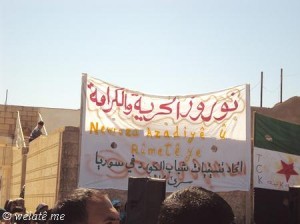Nowruz Under the Revolution

March 21 was the day Kurds celebrated the start of a new year; it is the “New Day”, or Nowruz, as it is called in Farsi.
Kurds make their preparations for this day, which also marks the start of spring, by buying new clothes, foodstuff, setting up tents in the open air, as well as lighting up their cities with candles on its eve. But the festivities in Syria took a new form this year due to the revolution. The Kurdish National Council, KNC, the umbrella group that gathers together most of the Kurdish parties and revolutionary committees, decided to hold the celebrations in a different manner. It was the KNC’s way of showing solidarity with Syrians throughout the rest of the country by turning Nowruz into a day of protest against the regime.
“In the past, we used to spend the entire day outdoors, but this year we limited the [celebrations] to three hours, which only included songs, cheers and revolutionary speeches,” said Mohammad Jameel, a leader in one of the Kurdish parties. “We also called on different segments of the Syrian society to participate in our celebrations,” he added.
The celebrations this year were held under the title “Forgive us Nowruz… Syria is bleeding”. In their statement, the organisers described the Syrian revolution as an embodiment of the essence of Nowruz, which, in the soul and memory of the Kurdish people, evokes “freedom and salvation from injustice”.
“Once the symbol of sacrifice, heroism and the start of a new year,” the statement continued, “ the month of March has now become a Syrian month par excellence thanks to [the heroism] that the Syrian people have shown through their revolution and extraordinary resilience.”
On the eve of Nowruz, Kurds staged sit-ins in Syrian cities with a majority Kurdish population, such as Amuda, Dereek, Qameshli and Ras Al-Ain, which is situated in the Al-Jazeera region. They also put in place rostrums decorated with the Kurdish and Syrian independence flags, as well as banners that called for democracy and pluralism to replace Assad’s regime. On the day of the feast, members of the KNC and youth revolutionary committees delivered speeches against the regime in both Kurdish and Arabic. The speeches stressed the importance of national unity in Syria, and confirmed that Kurds must stand by their Syrian brothers until the fall of the regime. As for the crowds, they cheered to the rhythm of revolutionary songs such those of the late Ibrahim Qashush, among others.
The celebrations joined people of all ages and backgrounds: Kurdish men, women and the elderly sat in large tents that were erected to receive guests along with Arab and Christian delegations who also attended the festivities in the province of Al-Hassaka.
Abdel Karim Saleem, an activist and member of a Kurdish youth revolutionary committee, expressed his feelings on the day of Nowruz.
“We have grown accustomed to celebrating this day every year and we avidly wait for it despite the regime’s harassment and its persecution of activists responsible for [organising the celebrations of] Nowruz,” said Saleem. “[Nowrus was different] this year was different despite the tragedy; every day we see dozens of our people in other cities get arrested and killed by a regime that has no mercy. Hence, it was our duty, for the sake of the sanctity of the revolution, to revere that blood and transform the celebrations into sweeping demonstrations in all Kurdish cities, and to prove to all the Syrians that Kurds have been part of this revolution since the first day.”
Delyar Abdu, a young Kurdish man, described his joy at participating in these celebrations.
“Never have I imagined myself living these happy days as a young man and cheering for the other cities [which are calling for] the fall of the regime,” he says.
Helen Mohammad expressed similar views.
“This beautiful day is a symbol of freedom, and the month of March has become a symbol of the freedom of all Syrians,” says Mohammad. “Today, we came out to cheer for Homs, Hama, Deraa and Deir ez-Zor. We share the fate of [the people of these cities] and pledge that the revolution shall continue as long as we live.”
Security forces kept their distance from the Nowruz demonstrations because they had already decided not to interfere with that day’s events. In the city of Dirbassiyyah, for example, a delegation of the Council of Civil Peace, CCP, which operates under the umbrella of the KNC, delivered a message to security forces informing them that the demonstrations were going to be peaceful. The message also stressed that the CCP will not accept any intervention on the part of the security members because it wanted to avoid clashes between Kurds and the authorities.
It is obvious that Syrian security forces have been very careful when dealing with Kurds since the start of the revolution. From time to time, they issue warnings against participating in demonstrations and even shoot at protesters in some of the large cities such as Qamishli and Al-Hassaka when they try to reach the city centre. Other areas such as Amuda, on the other hand, witnessed a big drawing down of the security presence.
This is the second year in a row that Kurds in Syria celebrate their most important holiday without fearing the regime’s repression. It has now become normal for Kurds to disclose their identity as well as take to the streets to protest.
